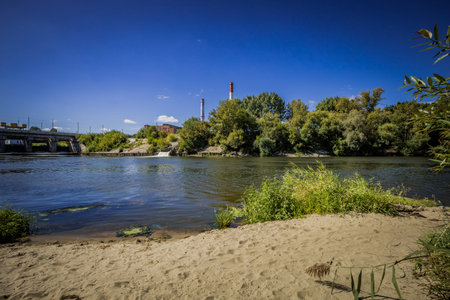Introduction to Scotland’s Legendary Salmon Rivers
Few countries can boast a fishing heritage as storied and evocative as Scotland’s, where the rhythm of salmon runs has shaped both landscape and lore for centuries. Amongst anglers and naturalists alike, four rivers stand tall: the Tweed, Dee, Spey, and Tay. These waterways are not merely conduits for Atlantic salmon but are woven into the fabric of Scottish identity, each carving its own path through a patchwork of heather-clad hills, ancient woodlands, and rolling farmland. From the Borders to the Highlands, these rivers offer more than just sport—they encapsulate the spirit of place, echoing with tales of legendary catches, tweed-clad ghillies, and mist-laden mornings. Their fame is rooted in prolific runs, distinct personalities shaped by geology and weather, and a shared history that has lured generations of rods from across Britain and beyond. Whether it’s the stately grandeur of the Tay or the brisk clarity of the Spey, these iconic rivers continue to inspire devotion and reverence—a testament to Scotland’s enduring love affair with its wild waters.
2. The Character of the Tweed: Border Traditions and Bountiful Runs
The River Tweed, winding gracefully through the rolling hills of the Scottish Borders, is more than just a salmon river—it is a living thread in the cultural tapestry of southern Scotland. Unlike its Highland cousins, the Tweed boasts a distinct character rooted in centuries-old traditions and a landscape shaped as much by human hands as by nature’s course. Here, angling is not merely sport but an enduring social ritual, with rods passed down through generations and beats named for their history as much as their productivity.
Unique Attributes of the Tweed
The Tweed’s reputation rests on several key attributes that set it apart among Scotland’s great salmon rivers. Notably, its waters are famed for exceptional clarity and a gentle pace, making them particularly inviting for fly anglers. The river’s length—spanning over 97 miles from the Lowther Hills to Berwick-upon-Tweed—offers an array of pools and glides, each with its own nuances and storied past. Much of the river is managed through private beats, ensuring careful stewardship and a traditional approach to access.
Table: Distinctive Features of the River Tweed
| Feature | Description |
|---|---|
| Best Known For | Autumn salmon runs and heritage-rich beats |
| Length | 97 miles (156 km) |
| Main Towns | Peebles, Kelso, Melrose, Berwick-upon-Tweed |
| Angling Tradition | Strong emphasis on fly fishing and beat rotation |
| Cultural Influence | Pivotal to Borders’ folklore and rural identity |
The Autumn Runs: A Seasonal Spectacle
If there is one season when the Tweed truly comes alive, it is autumn. From late September through November, shoals of Atlantic salmon ascend the river in remarkable numbers, drawing anglers from across Britain and beyond. This annual migration not only fills the pools with silver but also brings a palpable sense of anticipation to local communities—a rhythm marked by frosted mornings, rustling leaves, and the quiet excitement of rods being assembled at dawn.
The Tweed’s Cultural Legacy in the Borders
The influence of the Tweed extends far beyond its banks. In every riverside village and market town, you’ll find echoes of its presence: tweed cloth woven for warmth on chilly beats; Border songs sung in praise of “the silver tourists”; and festivals that celebrate both the catch and conservation. For many locals, fishing the Tweed is as much about belonging as it is about sport—a chance to participate in an age-old ritual that has shaped both land and life in this corner of Scotland.

3. The Dee: Granite Waters and Conservation Ethos
Tucked within the heart of Aberdeenshire, the River Dee is famed for its crystalline flow and wild Highland backdrops, where granite hillsides and ancient pinewoods frame each meander. Unlike its gentler southern cousin, the Tweed, the Dee’s waters run brisk and cold, filtered through rugged geology that bestows them with exceptional clarity. This river is not just a place for sport; it is a living emblem of Scotland’s enduring bond between landscape and tradition.
Anglers are drawn here by more than just the prospect of spring salmon—the Dee’s silvery fish are legendary—but also by the river’s fiercely protected natural character. Local ghillies, estate owners, and conservationists share a single-minded ethos: sustainability above all. Catch-and-release policies are widely embraced along the Dee, ensuring future generations can experience the same electric anticipation as today’s rods do when a fresh-run salmon takes hold in the shallows.
This commitment to stewardship is palpable on every beat. Fisheries management trusts work hand-in-glove with landowners to maintain healthy habitats, monitor stocks, and restore spawning grounds. Native heather and birch line the banks, while ospreys wheel overhead—a scene quintessentially Aberdeenshire in spirit and outlook. Here on the Dee, fishing is not merely a pastime but a partnership with nature, rooted in respect for both heritage and habitat.
4. The Spey: Heartland of Whisky and the Art of Spey Casting
Nestled in the heart of Moray and stretching northeast to the Moray Firth, the River Spey is a Scottish icon whose swift, peaty waters have shaped not only the landscape but also the traditions of salmon fishing and whisky making. The Spey’s rapid glides and gravelly runs offer a distinct challenge for anglers, fostering innovations that have become part of fly fishing lore—none more famous than the art of Spey casting. Developed out of necessity on this very river, where wide pools, high banks, and overhanging willows demand long casts with minimal backspace, Spey casting is now revered worldwide for its elegance and efficiency.
The river’s physical characteristics set it apart from its peers. Unlike the meandering Tweed or the deep channels of the Tay, the Spey’s swift current requires a deft touch and specialist tackle. Anglers here favour double-handed rods, traditional flies like the Silver Stoat or the Ally’s Shrimp, and lines designed specifically for roll casting across turbulent flows. The rhythm and grace demanded by these conditions have fostered a unique angling culture, one as refined as any single malt distilled along its banks.
Speyside: Whisky Country
But fishing is only half of the Spey’s legacy. As it winds through verdant valleys, it feeds not just Atlantic salmon but also an industry synonymous with Scotland itself: whisky. Over half of Scotland’s malt whisky distilleries are found within the Speyside region, relying on pure Spey water to craft drams renowned for their subtlety and complexity. There is a poetic symmetry here; both fly fishing and whisky making depend on patience, precision, and an intimate understanding of place.
At a Glance: The River Spey
| Feature | Description |
|---|---|
| Length | 107 miles (172 km) |
| Main Towns | Aviemore, Grantown-on-Spey, Fochabers |
| Fishing Season | 11 February – 30 September |
| Signature Tackle | Double-handed rods, floating/intermediate lines |
| Whisky Distilleries | Glenfiddich, Macallan, Glenlivet (and many more) |
The Spirit of Place
To fish the Spey is to experience a confluence of natural beauty and cultural heritage. Mornings might begin with mist curling above amber waters as oystercatchers call from shingle banks. Evenings are often spent beside a peat fire with a dram of local whisky in hand—perhaps contemplating that elusive springer caught at Delagyle or pondering how generations before perfected their casts under ancient Scots pines. The River Spey isn’t just a waterway; it’s a living tradition where every cast echoes centuries of craftsmanship and every sip speaks to the land itself.
5. The Tay: Majestic Flow and Record-Breaking Salmon
When it comes to grandeur and reputation, the River Tay stands as a true titan among Scotland’s iconic salmon rivers. Flowing through the heart of Perthshire, the Tay is not only the longest river in Scotland but also boasts an impressive breadth and depth that set it apart from its peers. Anglers who step onto its banks are often struck by the sheer scale of its waters—a broad, sweeping expanse that feels both untamed and inviting.
The Tay’s beats are renowned for their diversity and accessibility. From the upper stretches near Kenmore to the productive lower beats around Stanley and Scone Palace, each section offers something unique. Many of these beats are steeped in tradition, with picturesque ghillie huts dotting the landscape and time-honoured fishing techniques still practised today. It’s not uncommon to see classic Hardy rods or vintage tweed jackets—reminders of Scotland’s enduring angling heritage—being put to use along these storied banks.
What truly sets the Tay apart in the annals of Scottish salmon fishing is its history of record-breaking catches. In 1922, the river yielded what remains the largest rod-caught salmon ever landed in Britain—a staggering 64-pounder taken by Miss Georgina Ballantine at Caputh. This legendary fish still inspires awe among anglers nearly a century later, symbolising both the river’s potential and its place in sporting folklore.
Today, while monster salmon are less common, the Tay continues to produce consistent numbers of strong, hard-fighting fish throughout the season. Its spring run is especially cherished, drawing seasoned rods from across the UK who relish the challenge of early-season fishing amidst frosty mornings and mist-laden hillsides. Local towns like Dunkeld and Pitlochry buzz with anticipation each year as anglers descend for their chance at a Tay springer—a rite of passage for many devoted to Scotland’s wild rivers.
In Scottish culture, the Tay holds a special reverence—not just for its size, but for its role as a cradle of memories and tradition. Tales of epic battles between angler and salmon echo through local pubs, while conservation efforts continue to ensure future generations can experience this mighty river firsthand. For those seeking both adventure and a deep connection to Scotland’s angling past, few places rival the majestic flow of the River Tay.
6. Nature and Community: The Changing Face of Salmon Fisheries
The iconic salmon rivers of Scotland—the Tweed, Dee, Spey, and Tay—are not only storied landscapes for anglers but also living arteries that sustain local communities and ecosystems. In recent years, these rivers have faced mounting environmental challenges. Climate change, fluctuating water temperatures, habitat fragmentation, and the spread of invasive species have all taken their toll on wild salmon numbers. Once-reliable runs are now met with uncertainty, prompting widespread reflection among those whose lives revolve around the riverbanks.
Environmental Pressures: A Shared Struggle
Each river presents a distinct ecological tapestry, yet they share common struggles. Warmer winters and erratic rainfall patterns alter river flows, threatening crucial spawning grounds. Agricultural runoff and urbanisation add further strain, impacting water quality and the delicate balance upon which salmon depend. These shifts do not go unnoticed in the local villages and towns; for many residents, the health of their home river is a daily concern, woven into community life just as much as any annual gala or ceilidh.
Conservation at the Forefront
Amidst these challenges, robust conservation efforts have emerged. Organisations like the Atlantic Salmon Trust and local river trusts coordinate habitat restoration projects—from replanting native trees along banks to installing fish passes at historic weirs—demonstrating an enduring commitment to stewardship. Catch-and-release initiatives have become standard practice on many beats, reflecting a shift in angling culture from harvest to preservation. These efforts not only aim to protect salmon stocks but foster a deeper respect for the river’s entire ecosystem.
The Human-River Connection
For centuries, the Tweed, Dee, Spey, and Tay have shaped the character of their surrounding communities—providing livelihoods, inspiring folklore, and anchoring local identity. Today, this relationship endures but is undergoing transformation. Anglers mingle with conservationists at riverside events; schoolchildren participate in citizen science projects monitoring juvenile salmon; riverside pubs and ghillies adapt their trade to reflect new realities. The future of Scotland’s salmon fisheries now depends on this interconnectedness—where nature’s rhythms and human ingenuity meet in both challenge and hope.
7. Conclusion: Scotland’s Rivers as Living Heritage
As we draw together the threads of the Tweed, Dee, Spey, and Tay, it becomes clear that each river is more than just a waterway; they are living testaments to Scotland’s enduring wildness and cherished traditions. The Tweed enchants with its storied past and gentle meanders through Border country estates, offering anglers a quintessential blend of heritage and classic fly-fishing. The Dee, coursing through royal Deeside, is famed for its early season runs and brisk granite-banked currents, providing an atmospheric challenge amid heather-clad hills and ancient pines. The Spey, with its swift flows and whisky-laden banks, beckons aficionados with technical fishing in breathtaking Highland surrounds, where salmon rise against a backdrop of misty mountains and distilleries. Meanwhile, the mighty Tay, Scotland’s broadest river, promises powerful fish and grand scenery alike, from tranquil lochs to bustling Perthshire towns.
Collectively, these rivers embody a living heritage—ever-evolving yet steeped in tradition. Their banks have witnessed centuries of change while remaining havens for those who crave the subtle interplay of rod, river, and wild landscape. Whether drawn by the pursuit of Atlantic salmon or the serenity of nature’s theatre, anglers and wanderers alike find themselves returning year after year. In every cast and quiet moment by these waters, one senses not only the pulse of Scotland’s natural world but also the timeless spirit that continues to shape its riverside culture. For many, this allure endures—a testament to why Scotland’s iconic salmon rivers remain revered across generations.


